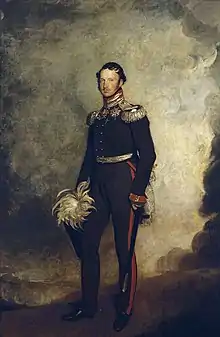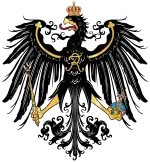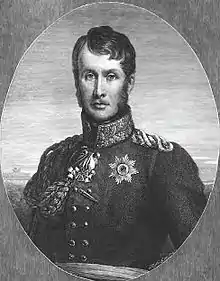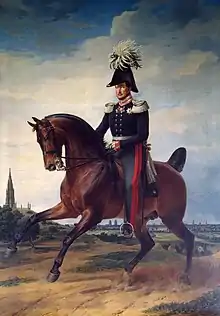Frederick William III of Prussia
Frederick William III (German: Friedrich Wilhelm III.; 3 August 1770 – 7 June 1840) was King of Prussia from 16 November 1797 until his death in 1840. He was concurrently Elector of Brandenburg in the Holy Roman Empire until 6 August 1806, when the Empire was dissolved.
| Frederick William III | |
|---|---|
 Portrait by Thomas Lawrence, c. 1814-1818 | |
| King of Prussia | |
| Reign | 16 November 1797 – 7 June 1840 |
| Predecessor | Frederick William II |
| Successor | Frederick William IV |
| Elector of Brandenburg | |
| Reign | 16 November 1797 – 6 August 1806 |
| Predecessor | Frederick William II |
| Successor | Electorate abolished |
| Born | 3 August 1770 Potsdam, Prussia |
| Died | 7 June 1840 (aged 69) Berlin, Prussia |
| Burial | Mausoleum at Charlottenburg Palace |
| Spouses | Louise of Mecklenburg-Strelitz
(m. 1793; died 1810)Auguste von Harrach (morganatic)
(m. 1824) |
| Issue see details... |
|
| House | Hohenzollern |
| Father | Frederick William II of Prussia |
| Mother | Frederica Louisa of Hesse-Darmstadt |
| Religion | Calvinist (until 1817) Prussian United (after 1817) |
| Signature |  |
| Prussian Royalty |
| House of Hohenzollern |
|---|
 |
| Frederick William III |
|
Frederick William III ruled Prussia during the difficult times of the Napoleonic Wars. The king reluctantly joined the coalition against Napoleon in the Befreiungskriege. Following Napoleon's defeat, he took part in the Congress of Vienna, which assembled to settle the political questions arising from the new, post-Napoleonic order in Europe. His primary interests were internal – the reform of Prussia's Protestant churches. He was determined to unify the Protestant churches to homogenize their liturgy, organization, and architecture. The long-term goal was to have fully centralized royal control of all the Protestant churches in the Prussian Union of Churches. The king was said to be extremely shy and indecisive. His wife Queen Louise (1776–1810) was his most important political advisor. She led a mighty group that included Baron vom Stein, Prince von Hardenberg, Gerhard von Scharnhorst, and Count von Gneisenau. They set about reforming Prussia's administration, churches, finance, and military. He was the common ancestor of Tsar Nicholas II of Russia (through Princess Charlotte) and Kaiser Wilhelm II (through Wilhelm I). He was the dedicatee of Beethoven’s Ninth Symphony in 1824.
Early life
_crop.jpg.webp)
Frederick William was born in Potsdam on 3 August 1770 as the son of Frederick William II of Prussia and Frederica Louisa of Hesse-Darmstadt. He was considered to be a shy and reserved boy, which became noticeable in his particularly reticent conversations, distinguished by the lack of personal pronouns. This manner of speech subsequently came to be considered entirely appropriate for military officers.[1] He was neglected by his father during his childhood and suffered from an inferiority complex his entire life.[2]
As a child, Frederick William's father (under the influence of his mistress,[3] Wilhelmine Enke, Countess of Lichtenau) had him handed over to tutors, as was quite normal for the period. He spent part of the time living at Paretz, the estate of the old soldier Count Hans von Blumenthal who was the governor of his brother Prince Heinrich. They thus grew up partly with the Count's son, who accompanied them on their Grand Tour in the 1780s. Frederick William was happy at Paretz, and for this reason, in 1795, he bought it from his boyhood friend and turned it into an important royal country retreat. He was a melancholy boy, but he grew up pious and honest. His tutors included the dramatist Johann Engel.
As a soldier, he received the usual training of a Prussian prince, obtained his lieutenancy in 1784, became a lieutenant colonel in 1786, a colonel in 1790, and took part in the campaigns against France of 1792–1794.[3] On 24 December 1793, Frederick William married Louise of Mecklenburg-Strelitz, who bore him ten children. In the Kronprinzenpalais (Crown Prince's Palace) in Berlin, Frederick William lived a civil life with a problem-free marriage, which did not change even when he became King of Prussia in 1797. His wife Louise was particularly loved by the Prussian people, which boosted the popularity of the whole House of Hohenzollern, including the King himself.[4]
Reign


Frederick William succeeded to the throne on 16 November 1797. He also became, in personal union, the sovereign prince of the Principality of Neuchâtel (1797–1806 and again 1813–1840). At once, the new King showed that he was earnest of his good intentions by cutting down the royal establishment's expenses, dismissing his father's ministers, and reforming the most oppressive abuses of the late reign.[3] He had the Hohenzollern determination to retain personal power but not the Hohenzollern genius for using it.[3] Too distrustful to delegate responsibility to his ministers,[3] he greatly reduced the effectiveness of his reign since he was forced to assume the roles he did not delegate. This is the main factor of his inconsistent rule.[5]
Disgusted with his father's court (in both political intrigues and sexual affairs), Frederick William's first and most successful early endeavor was to restore his dynasty's moral legitimacy. The eagerness to restore dignity to his family went so far that it nearly caused sculptor Johann Gottfried Schadow to cancel the expensive and lavish Prinzessinnengruppe project, which was commissioned by the previous monarch Frederick William II. He was quoted as saying the following, which demonstrated his sense of duty and peculiar manner of speech:
Every civil servant has a dual obligation: to the sovereign and the country. It can occur that the two are not compatible; then, the duty to the country is higher.
At first, Frederick William and his advisors attempted to pursue a neutrality policy in the Napoleonic Wars. Although they succeeded in keeping out of the Third Coalition in 1805, eventually, Frederick William was swayed by the queen's attitude, who led Prussia's pro-war party and entered into the war in October 1806. On 14 October 1806, at the Battle of Jena-Auerstädt, the French effectively decimated the Prussian army's effectiveness and functionality; led by Frederick William, the Prussian army collapsed entirely soon after. Napoleon occupied Berlin in late October. The royal family fled to Memel, East Prussia, where they fell on the mercy of Emperor Alexander I of Russia.
Alexander, too, suffered defeat at the hands of the French, and at Tilsit on the Niemen France made peace with Russia and Prussia. Napoleon dealt with Prussia very harshly, despite the pregnant Queen's interview with the French emperor, which was believed to soften the defeat. Instead, Napoleon took much less mercy on the Prussians than what was expected. Prussia lost many of its Polish territories and all territory west of the Elbe and had to finance a large indemnity and pay French troops to occupy key strong points within the Kingdom.
Although the ineffectual King himself seemed resigned to Prussia's fate, various reforming ministers, such as Heinrich Friedrich Karl vom und zum Stein, Prince Karl August von Hardenberg, Gerhard Johann David von Scharnhorst, and Count August von Gneisenau, set about reforming Prussia's administration and military, with the encouragement of Queen Luise (who died, greatly mourned, in 1810). After bereavement, Frederick William fell under the influence of a 'substitute family' of courtiers, among whom included Friedrich Ancillon, a Huguenot preacher that provided the king with strong ideological support against political reforms that might restrain monarchical power, Sophie Marie von Voß, an older woman with conservative views and Prince Wilhelm zu Sayn-Wittgenstein-Hohenstein.[6]
In 1813, following Napoleon's defeat in Russia, Frederick William turned against France and signed an alliance with Russia at Kalisz. However, he had to flee Berlin, still under French occupation. Prussian troops played a crucial part in the victories of the allies in 1813 and 1814, and the King himself traveled with the main army of Karl Philipp Fürst zu Schwarzenberg, along with Alexander of Russia and Francis of Austria.
At the Congress of Vienna, Frederick William's ministers succeeded in securing significant territorial increases for Prussia. However, they failed to obtain the annexation of all of Saxony, as they had wished. Following the war, Frederick William turned towards political reaction, abandoning the promises he had made in 1813 to provide Prussia with a constitution.[7]
Prussian Union of churches

Frederick William was determined to unify the Protestant churches to homogenize their liturgy, organization, and architecture. The long-term goal was to have fully centralized royal control of all the Protestant churches in the Prussian Union of churches. The merging of the Lutheran and Calvinist (Reformed) confessions to form the United Church of Prussia was highly controversial. Angry responses included a large and well-organized opposition. Especially the "Old Lutherans" in Silesia refused to abandon their liturgical traditions. The crown responded by attempting to silence protest. The stubborn Lutheran minority was coerced by military force, their churches' confiscation, and their pastors' imprisonment or exile. By 1834 outward union was secured based on common worship but separate symbols—the opponents of the measure being forbidden to form communities of their own. Many left Prussia. The King's unsuccessful counterattack worsened tensions at the highest levels of government. The crown's aggressive efforts to restructure religion were unprecedented in Prussian history. In a series of proclamations over several years, the Church of the Prussian Union was formed, bringing together the majority group of Lutherans and the minority group of Reformed Protestants. The main effect was that the government of Prussia had full control over church affairs, with the king himself recognized as the leading bishop.[8]
In 1824 Frederick William III remarried (morganatically) Countess Auguste von Harrach, Princess of Liegnitz.They had no children.[4]
In 1838 the king distributed large parts of his farmland at Erdmannsdorf Estate to 422 Protestant refugees from the Austrian Zillertal, who built Tyrolean style farmhouses in the Silesian village.
Death
Frederick William III died on 7 June 1840 in Berlin, from a fever,[9] survived by his second wife. His eldest son, Frederick William IV, succeeded him. Frederick William III is buried at the Mausoleum in Schlosspark Charlottenburg, Berlin.[4]
Issue
| Name | Birth | Death | Notes |
|---|---|---|---|
| (daughter, no name) | 1 October 1794 | 1 October 1794 | stillborn |
| Frederick William IV of Prussia | 15 October 1795 | 2 January 1861 | married Elisabeth Ludovika of Bavaria (1801–1873), no issue. |
| William I, German Emperor | 22 March 1797 | 9 March 1888 | married Princess Augusta of Saxe-Weimar-Eisenach (1811–1890), had issue. |
| Princess Charlotte of Prussia | 13 July 1798 | 1 November 1860 | married Nicholas I of Russia (1796–1855), had issue including the future Alexander II of Russia |
| Princess Frederica of Prussia | 14 October 1799 | 30 March 1800 | died in childhood |
| Prince Charles of Prussia | 29 June 1801 | 21 January 1883 | married Princess Marie of Saxe-Weimar-Eisenach (1808–1877), had issue. |
| Princess Alexandrine of Prussia | 23 February 1803 | 21 April 1892 | married Paul Friedrich, Grand Duke of Mecklenburg-Schwerin (1800–1842), had issue. |
| Prince Ferdinand of Prussia | 13 December 1804 | 1 April 1806 | died in childhood |
| Princess Louise of Prussia | 1 February 1808 | 6 December 1870 | married Prince Frederik of the Netherlands (1797–1881), had issue. |
| Prince Albert (Albrecht) of Prussia | 4 October 1809 | 14 October 1872 | married Princess Marianne of the Netherlands (1810–1883), had issue; married second to Rosalie von Rauch (1820–1879), Countess of Hohenau, had issue. |
Honours
.svg.png.webp) Prussia:
Prussia:
- Knight of the Black Eagle, 11 September 1772[10]
- Founder of the Iron Cross, 10 March 1813[11]
- Founder of the Order of Louise, 13 August 1814[11]
 Russian Empire:[12]
Russian Empire:[12]
- Knight of St. Andrew, 29 January 1780
- Knight of St. Alexander Nevsky, 29 January 1780
 Sweden:
Sweden:
- France:
.svg.png.webp) French Empire: Grand Eagle of the Legion of Honour, March 1805[15]
French Empire: Grand Eagle of the Legion of Honour, March 1805[15] Kingdom of France:[16]
Kingdom of France:[16]
- Knight of the Holy Spirit, 1815
- Knight of St. Michael, 1815
 Austrian Empire: Knight of the Military Order of Maria Theresa, 1813[17]
Austrian Empire: Knight of the Military Order of Maria Theresa, 1813[17].svg.png.webp) Spain: Knight of the Golden Fleece, 30 May 1814[18]
Spain: Knight of the Golden Fleece, 30 May 1814[18] United Kingdom: Knight of the Garter, 9 June 1814[19]
United Kingdom: Knight of the Garter, 9 June 1814[19] Denmark: Knight of the Elephant, 31 August 1814[11]
Denmark: Knight of the Elephant, 31 August 1814[11] Netherlands: Grand Cross of the Military William Order, 9 July 1821[20]
Netherlands: Grand Cross of the Military William Order, 9 July 1821[20].svg.png.webp) Saxe-Weimar-Eisenach: Grand Cross of the White Falcon, 1 March 1823[21]
Saxe-Weimar-Eisenach: Grand Cross of the White Falcon, 1 March 1823[21].svg.png.webp) Baden:[22]
Baden:[22]
- Grand Cross of the House Order of Fidelity, 1823
- Grand Cross of the Zähringer Lion, 1823
 Kingdom of Portugal: Grand Cross of the Sash of the Three Orders, 30 August 1825[23]
Kingdom of Portugal: Grand Cross of the Sash of the Three Orders, 30 August 1825[23].svg.png.webp) Kingdom of Bavaria: Knight of St. Hubert, 1826[24]
Kingdom of Bavaria: Knight of St. Hubert, 1826[24].svg.png.webp) Kingdom of Sardinia: Knight of the Annunciation, 6 May 1833[25]
Kingdom of Sardinia: Knight of the Annunciation, 6 May 1833[25].svg.png.webp)
.svg.png.webp)
.svg.png.webp) Ernestine duchies: Grand Cross of the Saxe-Ernestine House Order, November 1834[26]
Ernestine duchies: Grand Cross of the Saxe-Ernestine House Order, November 1834[26].svg.png.webp) Kingdom of Saxony: Knight of the Rue Crown, 1836[27]
Kingdom of Saxony: Knight of the Rue Crown, 1836[27] Grand Duchy of Hesse: Grand Cross of the Ludwig Order[11]
Grand Duchy of Hesse: Grand Cross of the Ludwig Order[11].svg.png.webp) Two Sicilies:[28]
Two Sicilies:[28]
- Knight of St. Januarius
- Grand Cross of St. Ferdinand and Merit
 Württemberg: Knight of the Golden Eagle[29]
Württemberg: Knight of the Golden Eagle[29]
Ancestry
| Ancestors of Frederick William III of Prussia[30] | |||||||||||||||||||||||||||||||||||||||||||||||||||||||||||||||||||||||||||||||||||||||||||||||||||||||||||||||||||||||||||||||||||||||||||||||||||||||||||||||||||||||||||||||||||||||||||||||||||||||||||||||||||||||||||||||||||||||||||||||||||||||||||||||||||||||||||||||||||||||||
|---|---|---|---|---|---|---|---|---|---|---|---|---|---|---|---|---|---|---|---|---|---|---|---|---|---|---|---|---|---|---|---|---|---|---|---|---|---|---|---|---|---|---|---|---|---|---|---|---|---|---|---|---|---|---|---|---|---|---|---|---|---|---|---|---|---|---|---|---|---|---|---|---|---|---|---|---|---|---|---|---|---|---|---|---|---|---|---|---|---|---|---|---|---|---|---|---|---|---|---|---|---|---|---|---|---|---|---|---|---|---|---|---|---|---|---|---|---|---|---|---|---|---|---|---|---|---|---|---|---|---|---|---|---|---|---|---|---|---|---|---|---|---|---|---|---|---|---|---|---|---|---|---|---|---|---|---|---|---|---|---|---|---|---|---|---|---|---|---|---|---|---|---|---|---|---|---|---|---|---|---|---|---|---|---|---|---|---|---|---|---|---|---|---|---|---|---|---|---|---|---|---|---|---|---|---|---|---|---|---|---|---|---|---|---|---|---|---|---|---|---|---|---|---|---|---|---|---|---|---|---|---|---|---|---|---|---|---|---|---|---|---|---|---|---|---|---|---|---|---|---|---|---|---|---|---|---|---|---|---|---|---|---|---|---|---|---|---|---|---|---|---|---|---|---|---|---|---|---|---|---|---|
| |||||||||||||||||||||||||||||||||||||||||||||||||||||||||||||||||||||||||||||||||||||||||||||||||||||||||||||||||||||||||||||||||||||||||||||||||||||||||||||||||||||||||||||||||||||||||||||||||||||||||||||||||||||||||||||||||||||||||||||||||||||||||||||||||||||||||||||||||||||||||
Siblings
- Frederica Charlotte (1767–1820), who became Duchess of York by her marriage to Frederick, Duke of York
- Christine (1772–73)
- Louis Charles (1773–96)
- Frederica Louisa Wilhelmina (1774–1837), wife of William of Orange, afterward King William I of the Netherlands
- Augusta (1780–1841), wife of William II, Elector of Hesse
- Henry (1781–1846)
- William (1783–1851)
Works
Marches
- Marsch I. Bataillon Garde, 1806
- Preussischer Präsentiermarsch, circa 1820
References
- Franz Blei (1931) "Königin Luise von Preußen" in Gefährtinnen. Berlin. pp. 68 ff
- Encyclopaedia Britannica, The Editors of (30 July 2018). "Federick William III". Encyclopaedia Britannica.
{{cite web}}:|first=has generic name (help) - . Encyclopædia Britannica. Vol. 11 (11th ed.). 1911. pp. 65–66.
- Ulrich Feldhahn (2011). Die preußischen Könige und Kaiser (in German). Kunstverlag Josef Fink, Lindenberg. pp. 17–20. ISBN 978-3-89870-615-5.
- Christopher Clark, Iron Kingdom: The Rise and Downfall of Prussia, 1600–1947 (2006) pp 298–320.
- Clark, Christopher (2006). Iron Kingdom: The Rise and Downfall of Prussia, 1600-1947. Cambridge, MA: Belknap Press. pp. 402]. ISBN 9780674023857.
- Martyn Lyons (2006) Post-revolutionary Europe, 1815–1856. Basingstoke: Palgrave Macmillan. p. 41. ISBN 9781137019806
- Christopher Clark (1996). "Confessional policy and the limits of state action: Frederick William III and the Prussian Church Union 1817–40". Historical Journal. 39 (4): 985–1004. doi:10.1017/S0018246X00024730. JSTOR 2639865. S2CID 159976974.
- Frank-Lothar Kroll (2006) Preussens Herrscher. Von den ersten Hohenzollern bis Wilhelm II. C.H. Beck, ISBN 3-406-54129-1, p. 218
- Liste der Ritter des Königlich Preußischen Hohen Ordens vom Schwarzen Adler (1851), "Von Seiner Majestät dem Könige Friedrich Wilhelm III. ernannte Ritter" p. 15
- J ..... -H ..... -Fr ..... Berlien (1846). Der Elephanten-Orden und seine Ritter. Berling. pp. 135–137.
- Almanach de la cour: pour l'année ... 1817. l'Académie Imp. des Sciences. 1817. pp. 61, 76.
- Per Nordenvall (1998). "Kungl. Maj:ts Orden". Kungliga Serafimerorden: 1748–1998 (in Swedish). Stockholm. ISBN 91-630-6744-7.
- Posttidningar, 30 april 1814, p. 2
- M. & B. Wattel (2009). Les Grand'Croix de la Légion d'honneur de 1805 à nos jours. Titulaires français et étrangers. Paris: Archives & Culture. p. 508. ISBN 978-2-35077-135-9.
{{cite book}}: CS1 maint: uses authors parameter (link) - Teulet, Alexandre (1863). "Liste chronologique des chevaliers de l'ordre du Saint-Esprit depuis son origine jusqu'à son extinction (1578-1830)" [Chronological List of Knights of the Order of the Holy Spirit from its origin to its extinction (1578-1830)]. Annuaire-bulletin de la Société de l'histoire de France (in French) (2): 113. Retrieved 21 April 2020.
- "Ritter-Orden: Militärischer Maria-Theresien-Orden", Hof- und Staatshandbuch des Kaiserthumes Österreich (in German), 1814, p. 18, retrieved 6 November 2019
- Guerra, Francisco (1819), "Caballeros Existentes en la Insignie Orden del Toison de Oro", Calendario manual y guía de forasteros en Madrid (in Spanish): 42, retrieved 17 March 2020
- Shaw, Wm. A. (1906) The Knights of England, I, London, p. 51
- Militaire Willems-Orde: Preussen, Friederich Wilhelm III von, (in Dutch)
- "Großherzoglicher Hausorden", Staatshandbuch für das Großherzogtum Sachsen / Sachsen-Weimar-Eisenach (in German), Weimar: Böhlau, 1835, p. 6, retrieved 11 March 2020
- Hof- und Staats-Handbuch des Großherzogtum Baden (1838), "Großherzogliche Orden" pp. 27, 42
- Bragança, Jose Vicente de (2011). "A Evolução da Banda das Três Ordens Militares (1789-1826)" [The Evolution of the Band of the Three Military Orders (1789-1826)]. Lusíada História (in Portuguese). 2 (8): 283. ISSN 0873-1330. Retrieved 17 March 2020.
- Hof- und Staatshandbuch des Königreichs Bayern: 1828. Landesamt. 1828. p. 7.
- Luigi Cibrario (1869). Notizia storica del nobilissimo ordine supremo della santissima Annunziata. Sunto degli statuti, catalogo dei cavalieri. Eredi Botta. p. 106.
- Adreß-Handbuch ... Sachsen-Coburg und Gotha (1837). "Herzogliche Sachsen-Ernestinischer Hausorden", p. 22
- Staatshandbuch für den Freistaat Sachsen: 1839. Heinrich. 1839. p. 4.
- Almanacco reale del regno delle Due Sicilie. Stamperia Reale. 1840. pp. 460, 464.
- Württemberg (1815). Königlich-Württembergisches Hof- und Staats-Handbuch: 1815. Guttenberg. p. 13.
- Genealogie ascendante jusqu'au quatrieme degre inclusivement de tous les Rois et Princes de maisons souveraines de l'Europe actuellement vivans [Genealogy up to the fourth degree inclusive of all the Kings and Princes of sovereign houses of Europe currently living] (in French). Bourdeaux: Frederic Guillaume Birnstiel. 1768., pp. 17 (father's side), 69 (mother's side)
Further reading
- Chisholm, Hugh, ed. (1911). . Encyclopædia Britannica. Vol. 11 (11th ed.). Cambridge University Press. pp. 65, 66.
- Clark, Christopher. Iron Kingdom: The Rise and Downfall of Prussia, 1600–1947 (2006) pp 298–320.
- Richardson, Constance. Memoirs of the Private Life and Opinions of Louisa, Queen of Prussia, Consort of Frederick William III (London, R. Bentley, 1847) online.
- Sheehan, James J. German History, 1770-1866 (1993) passim.
- Wright, Constance. Beautiful enemy: a biography of Queen Louise of Prussia (Dodd, Mead, 1969) online.
- v. Hartmann (1966), "Friedrich Wilhelm III.", Neue Deutsche Biographie (in German), vol. 7, Berlin: Duncker & Humblot, pp. 700–729; (Friedrich Wilhelm III. (König von Preußen).html full text online)
External links
 Media related to Frederick William III of Prussia at Wikimedia Commons
Media related to Frederick William III of Prussia at Wikimedia Commons
